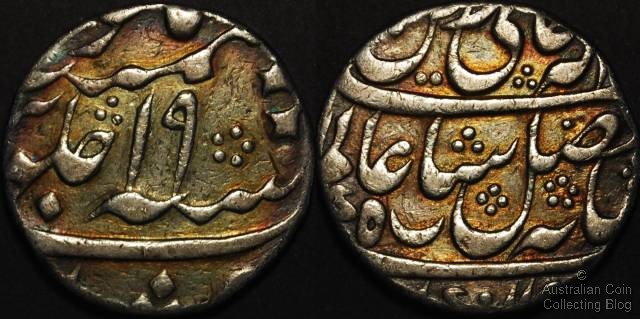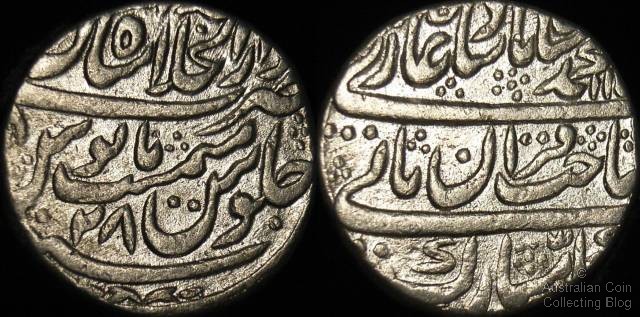
India Silver Rupee 1790 - Shah Alam
In my previous entry about Australian proclamation coins I mentioned the silver rupee of India valued at 2s 6d in the proclamation by Governor King of the Colony of New South Wales. Exactly what silver rupee Governor King was talking about in the Proclamation is unclear, as silver rupees were being struck in nearly 30 different Indian provinces at the time. Rupees could be crudely struck examples like that shown above, or more modern looking examples struck in a milled coining press. The rupee was introduced to India in the 16th Century and was supposed to contain 175 grains (or 11.33g) of silver. By the time of the proclamation the silver rupee being struck by the British East India Company comprised 180 grains (11.66g) of 88.8% fine silver. The EIC rupees (struck from 1773) are the most commonly accepted 'proclamation rupees' and were minted in the style of the Mughal Empire rupees. These EIC rupees were known as 'sicca' rupees, where 'sicca' translates loosely to 'widely and commonly accepted'. An example of one of these rupees is show above.
The obverse of these coins has the Arabic inscription "Emperor Shah Alam, defender of Mohammed's faith, shadow of grace of Allah, has struck this coin to be current in the seven climes". Typically much of this legend does not fit onto the flan of the coin and is missing.
The reverse of the EIC sicca rupees did not vary regardless of where the coin was struck. The Arabic inscription reads "Minted at Murshidabad the 19th year of the auspicious accession". The mint name did not vary despite some coins being minted in Dacca and Calcutta. The reason for the unaltering reverse was to prevent money changers and merchants in the capital city of Murshidabad discounting the value of rupees minted elsewhere.

India Silver Rupee 1747 - Mahomed Shah
Because of the sheer range of silver rupees being struck in India at the time of the Proclamation it is hard for the collector to know where to begin. I'd suggest looking for a non milled coin of the late 18th Century as these would have been the most common rupees at the time. If you can pin a coin down as being minted by the British East India Company then you've got the coin most likely to have been traded in the Colony of New South Wales at the time. It is easy to imagine that currency from the British Colonies of India made its way to the colonies in Australia on merchant ships at the time. When looking for a coin I'd try to find one with the year showing on the reverse, the year is shown in Arabic script so you'll need to learn a few Arabic numerals to be able to spot it. Look for something well centered and without cracks or adjustment marks. You should be looking for a high grade coin with a natural patina (that is not cleaned or dipped). Silver rupees are common and there's no real reason for settling for a lower grade example unless the eye appeal is very high.
Posted by mnemtsas at June 8, 2009 8:48 AM
Subscribe to our Newsletter


